We spend plenty of time drooling over the latest and greatest technology, whether it's traction control, GPS, or electronic suspension, but nobody here at Motorcyclist got into the two-wheeled world to study wiring diagrams or charts full of data. We like riding. And that's precisely why we love a test like this one. This latest batch of do-it-all machines has hardly a bell or whistle among them.
New for this year (and next, technically) are Honda's CBR650F and Yamaha's FZ-07, the former being Big Red's answer to the budget sportbike and the latter joining Yamaha's lineup as the little sibling of the FZ-09. To keep them honest are Kawasaki's stalwart Ninja 650 and Suzuki's SFV650 (don't call it a Gladius). A pair of them are faired and sporty while the other two are naked, with three different engine configurations (including two types of parallel twin). Some people will label them beginner bikes, and while it's true that all four would be on our short list for new riders, we prefer to think of them as ideal step-up sporty bikes. Motorcycling distilled. No razzle dazzle—just two wheels and a motor and little else.
To find out which one we would keep in our garage we put them all through the typical gamut of Motorcyclist tests. We found we could average at least 50 mpg on any of them and that they all could use a seventh gear, but we also discovered more differences than we saw on paper. From a scorching-hot quarter-mile drag test to the pizza-parlor parking lot, here's what we learned.
It’s a fair question because if you’re a motorcyclist you probably know a satisfied Ninja customer. The 650 has been a success for Kawasaki, from club racing to beginner riders, and its abundance on the roads is no accident.
Let’s start with the basics: looks and cost. Kawasaki’s sportbike pedigree runs deep, and you can see the resemblance to the potent ZX-6R and ZX-10R supersport siblings in edgy styling, petal-style front-brake rotors, and an angular, twin headlight. Getting all of that for $7,699 is an attractive proposition (our bike was an ABS model, incidentally, which adds just $300).
The sportbike lineage is less apparent from the saddle, but the Ninja 650 still has lots to offer. A low, inviting seat (31.7 inches) welcomes almost any inseam, and it’s one of the more comfortable saddles on the market too, even at the end of a long day. The footpegs are high, though, which will cramp taller riders, as will the tall, relatively pulled-back handlebar. All of this adds up to an unquestionably approachable package, especially for new or returning riders who are drawn to sporty styling and Kawasaki green.
Out on the open road the Ninja did nothing wrong but also failed to impress. Power from the 649cc twin is ample without being exciting, and the rubber-mounted footpegs and handlebar can make the machine feel a little disconnected. The noise from the tidy, under-slung exhaust is pleasing and makes powering out of corners more satisfying, provided you like the bark of a parallel twin. An upright riding position and low seat combine to put you in a less commanding position for sport riding. The suspension is a mixed bag, softly sprung but not particularly compliant; the other machines offer a better ride.
Like the suspension, the brakes are on the soft side. There is plenty of power to slow down—just not as much feel as the other bikes (here again, the rubber-mounted handlebar probably doesn’t help). Extra plumbing for the ABS system might be sapping some of the feedback, however it’s equally important to note the safety net that antilock brakes add. While we’re suckers for crisp brakes, it’s a good time to point out that $300 for an ABS upgrade is downright cheap.
Comfort for freeway travel on the Ninja seems to depend on the size of the rider. Our testers over six feet found the seat-to-peg distance too short, and the windscreen blasted turbulent air at the bottom of their helmets. Shorter riders appreciated the compact riding position, and the aerodynamics suited them much better.
Overall the Ninja 650 is a good option. It’s made a name for itself with an easygoing personality and modern looks, and it’s the second-cheapest bike of the group. Mostly it’s the feel of the Ninja that put it behind the others. The riding position is odd, the brakes and suspension lack feedback, and the motor doesn’t stand out, especially in this crowd.
Honda’s new-for-2014 CBR650F is a bit of a black sheep in this group. First, the inline four-cylinder engine makes power much differently than the other bikes in this test, which all sport twin-cylinder mills (we’ll get to that). The other thing is the price; at $8,499 the CBR650F is really scraping the ceiling of “budget,” especially in this performance bracket. Honda no doubt hopes the extra two cylinders will validate the steep sticker.
This is also the sportbike of the group, without a doubt. The Kawasaki is also fully faired, but all of that green bodywork merely disguises a standard bike underneath. This Honda, however, is the only bike here with clip-ons, putting you in a sporty crouch and a much more authoritative position than the Ninja. The seat is sportier, too, but still a far cry from an actual sportbike saddle. Honda is trying to make the CBR-F look like a budget-priced CBR600RR—notice how the oval-section steel frame almost looks like an aluminum-spar chassis?
Honda’s motor might seem familiar—a compact, liquid-cooled inline-four—but it’s not. It has almost nothing in common with the CBR600RR engine. The 650F powerplant gets its extra 50cc from stroke, rather than bore, to put an emphasis on midrange power. And sure enough, twisting the grip produces an even spread of power throughout the rev range. There are more revs to be had (almost 12,000) than any of the other bikes, but when it comes to midrange grunt, the Honda’s four cylinders still have trouble keeping up with the torquey twins.
Despite a long wheelbase (1.8 inches greater than the stubby Yamaha’s) and 465 pounds of heft, the 650F is pretty agile anywhere outside a parking lot. (None of our testers struggled with the height of the Honda’s seat, but it’s worth noting that it is the tallest of the group’s by a fraction.) The Honda benefits from a nicely balanced chassis with smooth, predictable steering and excellent brakes, easily the best of this bunch. (Our bike did not have ABS, a $500 option.) And while the suspension is softly calibrated, it remains controlled and surprisingly compliant, all things considered.
Amenities in the 650F’s cockpit are perhaps the most comprehensive of the group, with a modern, split dashboard that displays plenty of info without seeming cluttered. The tachometer is a digital bar type cleverly arranged in a semicircle so it’s easy to catch the rising revs out of the corner of your eye. Wind protection is also the best of this batch, directing most of the air away from the torso at freeway speeds. Taller riders will get windblast on their shoulders and arms, but the sporty riding position compensates nicely. In concept, the 650 slots perfectly in between the CBR500R and the CBR600RR.
In the end the CBR650F is a well-executed machine that plays the safe bet. It’s sporty but not the least bit rambunctious, handsome but not especially unique. We like this bike a lot, but the hefty sticker heightens expectations that aren’t quite met.
On the topic of expense, enter Suzuki’s SFV650. The SFV (then under the Gladius name) replaced the venerable unfaired SV650 in 2009 with a new look and a few drivetrain updates but not much new technology. It has been largely the same ever since, while the price has climbed from $6,899 in 2009 to $8,149 today. At a glance, the SFV is the second-priciest ride in this test and arguably the most dated.
So how does it finish runner-up in this shootout? It simply reminded us what a sweet package Suzuki started with. Many motorcyclists still lament the discontinuation of the original SV650, but the fact is that much of that spirit lives on in the SFV. Like the 645cc, 90-degree V-twin, tuned for more torque in Gladius guise (with dual spark heads and updated fuel mapping) but still a charismatic and entertaining powerplant.
The riding position, too, is reminiscent of the SV; a slight rise in the handlebar places you in a totally neutral stance. Combine the SFV’s trim figure with an unintimidating 30.9-inch seat height and you’ve got a much more approachable motorbike than the 449-pound curb weight would suggest. The footpegs are only half an inch farther from the saddle than the cramped Ninja, but it feels like more than that; there is plenty of room to move around without the pegs being too low to enjoy a twisty road.
In our first comparison with the SFV in 2009, one tester likened the seat to sitting on a “birchwood 2x4, end up,” and we tend to agree. It is definitely too stiff, but it must be just about the right shape because nobody here complained at any length. It would be a trivial bitch anyway because you’ll be distracted by the SFV’s playful character.
The V-twin offers a generous surge of power almost anywhere in the rev band, and while the exhaust note is too muted for our taste (the styling of the pipe didn’t win any hearts either), it still produces pleasing, 90-degree notes. When turned loose on a mountain road, the chassis will entertain riders of any level, which made us realize all of the little things that Suzuki got right: a well-spaced and precise transmission, solid brakes, and a prominent, analog tachometer to name a few.
But look a little longer at the instruments and you’ll see they’re quite dated. The dull backlight on the dash looks antiquated, especially at night, and while we love the conspicuous gear-position indicator, it does too much to illustrate what is obviously missing (no fuel gauge?). And who no ABS version, Suzuki?
Not that it hasn’t been said before, but if Suzuki’s design staff could trim the fat off the SFV and spruce it up with an aesthetic that’s not trying so hard to be cool—while keeping the SFV’s fun-loving personality—they (and we) would be sitting on a winner.
Yamaha’s all-new FZ-07 was the undisputed winner of this test, but it wasn’t necessarily the landslide you might be expecting. A combination of factors create such a compelling machine. Sure, the price and curb weight are low and it will wheelie in third gear, but it’s the way this motorcycle is packaged that makes it so charming.
At 689cc, the FZ’s engine benefits from a slight displacement advantage over the competition, but it’s not the amount of power that makes the motor satisfying. It’s the way this parallel twin makes power, thanks to a 270-degree crankshaft and an uneven firing order that creates a more dynamic personality than a typical vertical twin.
Peak output is sandwiched between the Kawasaki and the Suzuki (and well below the Honda), but you wouldn’t know it from the saddle. The FZ-07’s mill is always ready to slap a healthy portion of torque on your plate—but never abruptly. The soft throb of the exhaust note accurately foreshadows the engine’s delivery: mellow, but strong, and totally competent.
Everything else about the FZ follows suit. The dash is comprehensive, prominently displaying gear position, speed, and rpm without being confusing. Dual Advics calipers squeeze 282mm discs up front (the smallest in the test), offering good feedback and plenty of power, though for now there’s no ABS option available. The FZ-07’s suspension delivers a mature compromise of comfort and agility, which is lucky because other than preload for the KYB shock there are no adjustments available.
The riding position is open and modern, seemingly geared toward an urban environment. Much more so than the other bikes here, the FZ feels almost supermoto-like, as though the rider sits on top of the bike, rather than in it. Yamaha clearly put effort into making the FZ slim in the middle, and shorter riders will appreciate it because the seat feels a little taller than 31.7 inches. The saddle is wide and soft at the back but narrow and oddly shaped at the front, which is where you spend most of your time.
The major ergonomic advantage that the FZ-07 has is its amazingly low weight. Tipping the scales at 400 pounds exactly makes it 50 (!) pounds daintier than the next-lightest Suzuki. It does have the advantage of a small fuel tank (only 3.7 gallons), but even full to the brim it’s noticeably lighter coming off the kickstand than any of the other bikes.
All of this adds up to a truly entertaining ride, regardless of setting. The commanding riding stance and torque-laden motor make the FZ a terrific around-towner, and competent suspension and brakes turn any twisty road into a playground. One blemish in the Yamaha’s luster is freeway comfort, with a high riding position and no wind protection. But the FZ-07 gives up very little overall comfort, even to the faired bikes in this test.
Arguably the most impressive piece of Yamaha’s new FZ-07 is the price tag, $6,990. Make no mistake, if all of the bikes in this comparison were the same price, the FZ-07 would still win. It’s not a standout in any one performance category; it just delivers everything a bike in this class should. And the fact that Yamaha can manage to create such an entertaining and practical motorcycle and sell it for roughly $1,000 less than the competition is too much value to pass up. It is, to say it simply, the best of a truly fun class of motorcycle
It’s a tight race on the dyno chart, but the Yamaha’s ultra fat and flat torque curve is notable. Honda’s CBR650F is the odd duck; there is definitely more power up top, but it suffers early in the rev range. The Suzuki’s motor feels stronger and more dynamic than the graph suggests.
A long day on the Honda might have your wrists cramping, though for a sportbike it’s pretty agreeable. The FZ-07 gets bonus points for tall riders; look at all of that legroom! The Ninja is the opposite, though the tight rider triangle will have shorter riders smiling. Suzuki’s SFV650 is a one-size-fits-all, provided you don’t mind a stiff saddle.
ZACK COURTS
ASSOCIATE EDITOR
AGE: 30
HEIGHT: 6'2"
WEIGHT: 185 lb.
INSEAM: 34 in.
Everyone always makes fun of Suzuki’s SFV650, mostly because it doesn’t stack up to the golden reputation of the original SV650 (the word “Gladius” still makes Ari break out in a cold sweat). And I agree, I definitely don’t like the bulbous, swoopy styling. But, man, what a nice bike! It’s compact and inviting, and yet it fits me just fine. The motor is great too: plenty of pep (second-gear wheelies!) but docile enough for new riders.
Controversial looks aside, I’d have an SFV long before a Ninja 650 or Honda’s new CBR650F. The Kawasaki’s ergos simply do not work for me (what are the pegs doing up there?), and the Honda’s inline-four engine doesn’t stack up to any of the twins.
It’s all moot anyway; this test was Yamaha’s. The FZ-07 is lighter, cheaper, and more fun than any other bike here. Could it be better than an FZ-09?
ARI HENNING
ROAD TEST EDITOR
AGE: 29
HEIGHT: 5'10"
WEIGHT: 171 lb.
INSEAM: 33 in.
These are real-world motorcycles at reasonable prices, though Honda is pushing the envelope in regards to the latter. The new CBR650F is a nice bike and the one to choose if you’re after that four-cylinder scream, but $8,500 is a lot to charge for it.
I’ve owned two SV650s in the past, so I’m quite fond of the SFV’s platform. It’s a shame that Suzuki beat the SFV with the ugly stick because beneath that over-stylized exterior is a really terrific bike. If it cost $6,500, I might consider it.
If it had been released as a 2014 model, there’s no doubt the FZ-07 would have won “Best Bang for the Buck” in this issue’s MOTY awards. It’s substantially better than the other bikes in nearly all respects and significantly less expensive. Mark the FZ-07 down as another home run for Yamaha.
JESSICA PROKUP
GUEST TESTER
AGE: 38
HEIGHT: 5'5"
WEIGHT: 115 lb.
INSEAM: 31 in.
The Ninja 650R does absolutely nothing interesting and nothing as well as the other models. The SFV performs better, but it’s bland—like the nice guy everyone talks to for a minute then ignores. The CBR650F stands out for its true supersport feel—nimble and (relatively) fast, with solid midrange power for an inline-four.
But only one bike offers a truly unique experience: the FZ-07. My first thought was, “Supermoto-like but way better.” It feels incredibly small, especially when leaned over, which combined with the light steering make it highly flickable. But it’s stable, staying planted even on lumpy pavement mid-corner. The motor has a twin’s fun character and usable power, the styling is modern badass, and the ergos are comfortable. Most importantly, it’s the only bike that had me smiling the whole time I rode it.














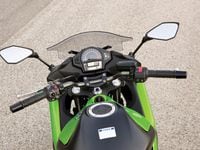
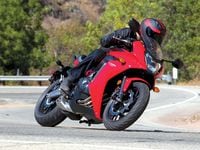

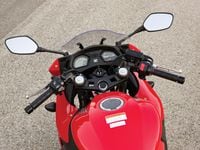


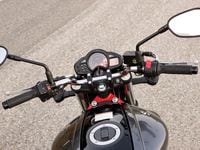
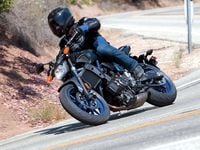

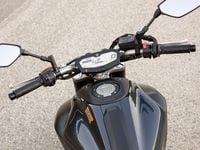


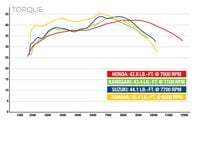
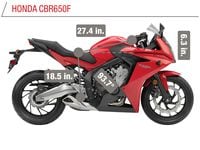


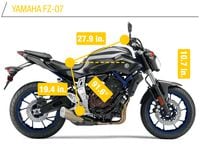

/cloudfront-us-east-1.images.arcpublishing.com/octane/7GJYDUIPXRGMTMQKN6ONYOLBOU.jpg)
/cloudfront-us-east-1.images.arcpublishing.com/octane/MUQLOVLL2ZDGFH25ILABNBXKTI.jpg)
/cloudfront-us-east-1.images.arcpublishing.com/octane/TNOU5DNE2BC57MFPMGN2EIDXAM.jpg)
/cloudfront-us-east-1.images.arcpublishing.com/octane/GTCXACQGJ5HAPDTGWUQKDEH44E.jpg)
/cloudfront-us-east-1.images.arcpublishing.com/octane/S35YGSEMEZB4BLTDJTSZPF4GLA.jpg)
/cloudfront-us-east-1.images.arcpublishing.com/octane/5UOT6HPX2JFMRJAX6EH45AR4MQ.jpg)
/cloudfront-us-east-1.images.arcpublishing.com/octane/OKWOJWAKP5EP3OACCRRWPCIX2Q.jpg)
/cloudfront-us-east-1.images.arcpublishing.com/octane/2WF3SCE3NFBQXLDNJM7KMXA45E.jpg)
/cloudfront-us-east-1.images.arcpublishing.com/octane/G4MG6OUCJNBSHIS2MVVOTPX65E.jpg)
/cloudfront-us-east-1.images.arcpublishing.com/octane/IIGGWFOTOJGB7DB6DGBXCCMTDY.jpg)
/cloudfront-us-east-1.images.arcpublishing.com/octane/QSTCM6AVEZA5JJBUXNIQ3DSOF4.jpg)
/cloudfront-us-east-1.images.arcpublishing.com/octane/U4I7G625B5DMLF2DVIJDFZVV6M.jpg)
/cloudfront-us-east-1.images.arcpublishing.com/octane/B6XD6LS6IVCQPIU6HXDJSM3FHY.jpg)
/cloudfront-us-east-1.images.arcpublishing.com/octane/ICL63FEDDRDTTMINYICCEYGMDA.jpg)
/cloudfront-us-east-1.images.arcpublishing.com/octane/FCGZHQXRBZFLBAPC5SDIQLVF4I.jpg)
/cloudfront-us-east-1.images.arcpublishing.com/octane/WNOB6LDOIFFHJKPSVIWDYUGOPM.jpg)

/cloudfront-us-east-1.images.arcpublishing.com/octane/X33NU3E525ECRHXLNUJN2FTRKI.jpg)
/cloudfront-us-east-1.images.arcpublishing.com/octane/6KKT5NNL2JAVBOXMZYS5ZO76YA.jpg)
/cloudfront-us-east-1.images.arcpublishing.com/octane/J5RKG5O455GMPGQRF2OG6LRT7A.jpg)
/cloudfront-us-east-1.images.arcpublishing.com/octane/GX2CIZKQVRH2TATDM26KFG2DAE.jpg)
/cloudfront-us-east-1.images.arcpublishing.com/octane/ZWIDYSAKQZHD5BHREMQILXJCGM.jpg)
/cloudfront-us-east-1.images.arcpublishing.com/octane/CYUHJZCTSJCH3MRAQEIKXK7SCQ.jpg)
/cloudfront-us-east-1.images.arcpublishing.com/octane/LKOFINY56FCXJCANJ5M7ZDQUBY.jpg)